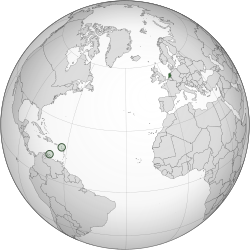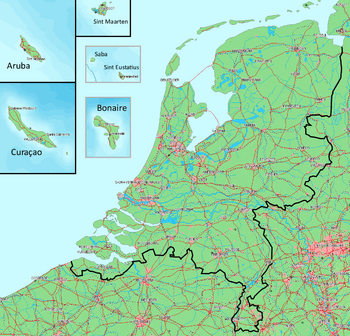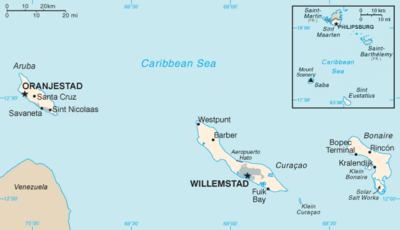Kingdom of the Netherlands facts for kids
Quick facts for kids
Kingdom of the Netherlands
Koninkrijk der Nederlanden (Dutch)
Keninkryk fan Nederlân (West Frisian) Reino Hulandes (Papiamento) |
|
|---|---|
 |
|

Map of the four constituent countries shown to scale
|
|
| Capital and largest city
|
Amsterdam 52°22′N 4°53′E / 52.367°N 4.883°E |
| Government seat | The Hague |
| Official languages | Dutch |
| Official regional languages | |
| Recognised languages |
|
| Demonym(s) | Dutch |
| Countries (non‑sovereign parts) | |
| Government | Devolved unitary parliamentary constitutional monarchy |
|
• Monarch
|
Willem-Alexander |
| Dick Schoof | |
|
• Minister Plenipotentiary of Aruba
|
Guillfred Besaril |
| Independence | |
| 26 July 1581 (declared) 30 January 1648 (recognised) |
|
|
• Batavian Republic
|
19 January 1795 |
| 5 June 1806 | |
|
• Annexation by First French Empire
|
1 July 1810 |
|
• Kingdom of the Netherlands
|
16 March 1815 |
|
• Secession of Belgium
|
4 October 1830 (declared) 19 April 1839 (recognised) |
|
• Charter for the Kingdom
(colonial inclusion) |
15 December 1954 |
| Area | |
|
• Total
|
42,531 km2 (16,421 sq mi) (131st) |
|
• Water (%)
|
18.96 |
| Population | |
|
• 2023 estimate
|
|
|
• Density
|
532/km2 (1,377.9/sq mi) |
| Currency |
4 currencies
|
| Time zone | European Netherlands: CET (UTC+1) CEST (UTC+2) (DST) Caribbean Netherlands: AST (UTC-4) DST not observed |
| Date format | dd-mm-yyyy |
| Driving side | right |
| Calling code |
4 codes
+31 (Netherlands)
+297 (Aruba) +599 (Curaçao / Caribbean) +1 721 (Sint Maarten) |
| ISO 3166 code | NL |
| Internet TLD | |
The Kingdom of the Netherlands (Dutch: Koninkrijk der Nederlanden, West Frisian: Keninkryk fan Nederlân, Papiamento: Reino Hulandes), often called simply the Netherlands, is a sovereign state. It is made up of different parts that are all united under the monarch of the Netherlands. The monarch acts as the head of state.
This kingdom is not a group of separate states. It is a single monarchy. Its largest part, the country called the Netherlands, is mostly in Northwestern Europe. It also includes several smaller islands in the Caribbean.
The Kingdom has four main parts: Aruba, Curaçao, the Netherlands, and Sint Maarten. These are called "constituent countries" and work together as equal partners. However, the European part of the Netherlands handles most of the Kingdom's business. This is because it makes up about 98% of the Kingdom's land and population.
Because of this, Aruba, Curaçao, and Sint Maarten depend on the European Netherlands for things like foreign policy and defense. But they also have their own parliaments and a lot of freedom to manage their own affairs.
Most of the land area of the country called the Netherlands is in Europe. But it also has three special municipalities in the Caribbean: Bonaire, Saba, and Sint Eustatius. The other three constituent countries (Aruba, Curaçao, Sint Maarten) are also in the Caribbean. In 2023, the European Netherlands had over 17.8 million people. The Caribbean special municipalities had about 29,418 people.
Contents
History of the Kingdom
The Kingdom of the Netherlands began after the defeat of French Emperor Napoleon I in 1815. In that year, the Netherlands became independent from France again. France had taken over its northern neighbor in 1810. The powerful countries of Europe decided to create a single state. This new state included the areas that were once the Dutch Republic, the Austrian Netherlands, and the Prince-Bishopric of Liège.
William, Prince of Orange and Nassau, was given control over this new state. In March 1815, Prince William became the "king of the Netherlands". After Napoleon's final defeat at the Battle of Waterloo in June 1815, other countries officially recognized William as king. The new king of the Netherlands also became the Grand Duke of Luxembourg.
Independence for Belgium and Luxembourg
In 1830, the southern parts of the Kingdom, which called themselves Belgians, broke away. The Netherlands officially recognized this in 1839 with the Treaty of London. At that time, Luxembourg became a fully independent country. It shared its ruler with the Netherlands, but was separate. Luxembourg also lost more than half of its land to Belgium.
How Colonies Became Independent
The Netherlands ended slavery in its colonies in 1863.
A big change happened in 1954 for the Kingdom's administration. This was inspired by the 1941 Atlantic Charter. This charter said that "all peoples" had the right to choose their own government. Queen Wilhelmina spoke about this in 1942. She said that after the war, the Netherlands wanted to change its relationship with its colonies. The goal was for overseas territories to be equal partners in the Kingdom.
After Indonesia became independent, the Netherlands reorganized its other colonial areas. The Charter for the Kingdom of the Netherlands was created in 1954. This charter formed a "Tripartite Kingdom of the Netherlands." It included the Netherlands (the main European part), Suriname, and the Netherlands Antilles.
Under this Charter, Suriname and the Netherlands Antilles gained a lot of self-rule. They each had a special minister in the Netherlands. These ministers could join Dutch government meetings when Kingdom matters were discussed.
Before 1954, Suriname and the Netherlands Antilles were simply colonies. Suriname was a constituent country from 1954 to 1975, when it became an independent republic. The Netherlands Antilles was a constituent country from 1954 until 2010.
In 1986, Aruba left the Netherlands Antilles to become its own constituent country. In October 2010, the Netherlands Antilles was dissolved. Curaçao and Sint Maarten then became the newest constituent countries of the Kingdom.
Recent Kingdom Events
The Kingdom celebrated its 200th anniversary with many events. These celebrations took place from 2013 to 2015. The last year, 2015, marked the actual 200th year of the Kingdom.
Constituent Countries of the Kingdom
The Kingdom of the Netherlands has four main parts, called constituent countries. These are the Netherlands, Aruba, Curaçao, and Sint Maarten. It is important to know the difference between the Kingdom of the Netherlands and the Netherlands. The Kingdom is the entire sovereign state. The Netherlands is just one of its four constituent countries.
Three Caribbean islands (Aruba, Curaçao, and Sint Maarten) are the three other constituent countries. Three other Caribbean islands (Bonaire, Sint Eustatius, and Saba) are special municipalities. These special municipalities are part of the country of the Netherlands itself.
| Country | Population (as of November 2019) |
Percentage of Kingdom's population |
Area | Percentage of Kingdom's area |
Population density | ||
|---|---|---|---|---|---|---|---|
| Subdivision | |||||||
| 17,424,978 | 98.24% | 41,873 km2 (16,167 sq mi) | 98.45% | 516/km2 (1,340/sq mi) | |||
| 17,399,821 | 98.10% | 41,545 km2 (16,041 sq mi) | 97.68% | 521/km2 (1,350/sq mi) | |||
| 20,104 | 0.11% | 288 km2 (111 sq mi) | 0.69% | 69/km2 (180/sq mi) | |||
| 3,138 | 0.02% | 21 km2 (8.1 sq mi) | 0.05% | 150/km2 (390/sq mi) | |||
| 1,915 | 0.01% | 13 km2 (5.0 sq mi) | 0.03% | 148/km2 (380/sq mi) | |||
| 112,309 | 0.63% | 180 km2 (69 sq mi) | 0.42% | 624/km2 (1,620/sq mi) | |||
| 158,665 | 0.89% | 444 km2 (171 sq mi) | 1.04% | 358/km2 (930/sq mi) | |||
| 41,486 | 0.23% | 34 km2 (13 sq mi) | 0.08% | 1,221/km2 (3,160/sq mi) | |||
| 17,737,438 | 100.00% | 42,525 km2 (16,419 sq mi) | 100.00% | 515/km2 (1,330/sq mi) | |||
| † Forms a part of the Dutch Caribbean. ‡ Forms a part of the Caribbean Netherlands. |
|||||||
Comparison table
| Subdivision | Currency | Major languages | Major religions |
|---|---|---|---|
| Netherlands | Euro | Dutch | No religion, Christianity |
| Bonaire | US dollar | Papiamento, Dutch (official) | Catholic, Protestant |
| Sint Eustatius | US dollar | English, Dutch (official) | Protestant, Catholic |
| Aruba | Aruban florin | Papiamento, Dutch (official), Spanish | Catholic |
| Saba | US dollar | English, Dutch (official) | Catholic |
| Curaçao | Netherlands Antillean guilder | Papiamento, Dutch (official) | Catholic |
| Sint Maarten | Netherlands Antillean guilder | English, Dutch (official), Spanish | Catholic, Protestant |
The European Netherlands
The Netherlands is a country with a parliamentary democracy. This means people vote for representatives to make laws. The country is led by the Monarch and the Council of Ministers. The Prime Minister (currently Dick Schoof) leads this council.
The people are represented by the States General of the Netherlands. This group has two parts: the House of Representatives and a Senate. The Netherlands is divided into 12 provinces. These provinces are then divided into smaller areas called municipalities. The currency used in the European Netherlands is the Euro.
Caribbean Netherlands: Bonaire, Sint Eustatius, and Saba
The special municipalities of Bonaire, Sint Eustatius, and Saba are in the Caribbean. They are part of the country of the Netherlands but not part of any Dutch province. They are like regular Dutch municipalities with a mayor and a council. People living on these islands can vote in Dutch national elections.
However, some rules are different for these islands. For example, their social security system is not the same as in the European Netherlands. Since 2011, the U.S. dollar has been their currency.
Aruba, a Constituent Country
Aruba is a constituent country with its own government system. It is a parliamentary democracy. The Governor represents the Monarch. The Aruban Council of Ministers is led by a Prime Minister. The people of Aruba are represented by 21 members in the Parliament of Aruba.
The current Governor of Aruba is Alfonso Boekhoudt. The Prime Minister is Evelyn Wever-Croes. Aruba has its own Central Bank and currency, the Aruban florin. This currency is linked to the U.S. dollar, which is also widely accepted on the island. Aruba has two official languages: its own national language Papiamento and Dutch.
Curaçao, a Constituent Country
Curaçao is also a constituent country with its own government. It is a parliamentary democracy. The Governor represents the Monarch. The Curaçao Council of Ministers is led by a Prime Minister. The people of Curaçao are represented by 21 members of parliament.
The current Governor of Curaçao is Lucille George-Wout. The Prime Minister is Gilmar Pisas. Curaçao uses the Netherlands Antillean guilder as its currency.
Sint Maarten, a Constituent Country
Sint Maarten is another constituent country. Its government is similar to Aruba's. It uses the Antillean Guilder as its currency. Unlike the other Dutch Caribbean countries, Sint Maarten covers only part of an island. It is the southern half of the island of Saint Martin. The northern half of the island is French.
How the Kingdom is Governed
Rules and Laws
Aruba, Curaçao, and Sint Maarten each have their own rules for how they are governed. These rules are called constitutions. However, these constitutions must follow the main rules set out in the Charter for the Kingdom of the Netherlands. The European Netherlands is governed by its own Constitution. This Constitution also sets up the rules for the Kingdom as a whole, as mentioned in the Charter.
The Charter explains that some rules apply to the whole Kingdom. These rules are used when they directly affect Aruba, Curaçao, or Sint Maarten. If a Kingdom matter only affects the European Netherlands, then the European Netherlands acts alone, following its own Constitution. Changes to the Charter for the Kingdom of the Netherlands can only happen if all constituent countries agree.
Kingdom's Government

The Monarch and the ministers they choose form the Government of the Kingdom. The Council of Ministers of the Kingdom of the Netherlands includes the ministers from the European Netherlands. It also includes one special minister from Aruba, one from Curaçao, and one from Sint Maarten. The Dutch Prime Minister leads this Council.
The Monarch of the Netherlands is the head of state for the entire Kingdom. In Aruba, Curaçao, and Sint Maarten, the Monarch is represented by a governor.
Defense of the Kingdom
The Netherlands Armed Forces (Dutch: Nederlandse krijgsmacht) are the shared military services for all countries in the Kingdom. They are managed by the Ministry of Defense.
Lawmaking Body
The lawmaking body of the Kingdom includes the States General of the Netherlands and the Government. The parliaments of Aruba, Curaçao, and Sint Maarten also have some say in Kingdom laws.
Council of State
There is a special group called the Council of State of the Kingdom. If Aruba, Curaçao, or Sint Maarten ask, a member from their island can join this Council. Aruba currently has a member on this Council.
Kingdom's Justice System
The Hoge Raad der Nederlanden is the highest court for the entire Kingdom. This court handles appeals from the Netherlands, Aruba, and Curaçao.
The Charter says that laws about civil and commercial law, criminal law, and other important areas should be as similar as possible across the Netherlands, Aruba, Curaçao, and Sint Maarten. If a big change is planned for these laws, the governments of the other countries must be asked for their opinion.
Geography of the Kingdom

The Kingdom of the Netherlands covers a total area of 42,531 km2 (16,421 sq mi). Its land area is 34,467 km2 (13,308 sq mi). The European part of the Netherlands shares land borders with Belgium and Germany. On the island of Saint Martin, it shares a border with France.
About one-quarter of the European Netherlands is below sea level. This is because much of the land has been reclaimed from the sea. Dikes are built to protect the land from flooding. The highest point in the Kingdom is Mount Scenery on Saba, which is 887 m; 2,910 ft high.
The Caribbean parts of the Kingdom are islands in the West Indies. The Leeward Islands (Saba, Sint Eustatius, and Sint Maarten) are volcanic and hilly. The Leeward Antilles (Aruba, Bonaire, and Curaçao) have less volcanic activity.
The Caribbean islands have a tropical climate, meaning it is warm all year. The Leeward Islands can experience hurricanes in the summer. The European part of the Netherlands has a moderate maritime climate. This means it has cool summers and mild winters.
See also
 In Spanish: Reino de los Países Bajos para niños
In Spanish: Reino de los Países Bajos para niños
- Koninkrijksdag
- Netherlands-Indonesia Union – a confederation between the Kingdom of the Netherlands and the United States of Indonesia
- West Indies Federation (1958–1962) – made up of 10 provinces of the UK





